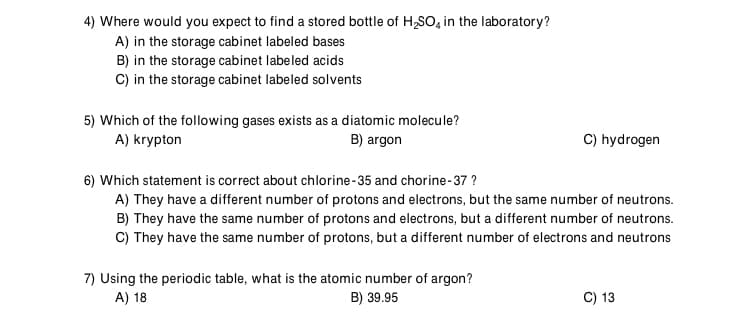4) Where would you expect to find a stored bottle of H,So, in the laboratory? A) in the storage cabinet labeled bases B) in the storage cabinet labeled acids C) in the storage cabinet labeled solvents 5) Which of the following gases exists as a diatomic molecule? A) krypton C) hydrogen B) argon 6) Which statement is correct about chlorine-35 and chorine-37 ? A) They have a different number of protons and electrons, but the same number of neutrons. B) They have the same number of protons and electrons, but a different number of neutrons. C) They have the same number of protons, but a different number of electrons and neutrons 7) Using the periodic table, what is the atomic number of argon? A) 18 C) 13 B) 39.95
4) Where would you expect to find a stored bottle of H,So, in the laboratory? A) in the storage cabinet labeled bases B) in the storage cabinet labeled acids C) in the storage cabinet labeled solvents 5) Which of the following gases exists as a diatomic molecule? A) krypton C) hydrogen B) argon 6) Which statement is correct about chlorine-35 and chorine-37 ? A) They have a different number of protons and electrons, but the same number of neutrons. B) They have the same number of protons and electrons, but a different number of neutrons. C) They have the same number of protons, but a different number of electrons and neutrons 7) Using the periodic table, what is the atomic number of argon? A) 18 C) 13 B) 39.95
Living By Chemistry: First Edition Textbook
1st Edition
ISBN:9781559539418
Author:Angelica Stacy
Publisher:Angelica Stacy
ChapterU4: Toxins: Stoichiometry, Solution Chemistry, And Acids And Bases
Section: Chapter Questions
Problem SI3RE
Related questions
Question

Transcribed Image Text:4) Where would you expect to find a stored bottle of H,SO, in the laboratory?
A) in the storage cabinet labeled bases
B) in the storage cabinet labeled acids
C) in the storage cabinet labeled solvents
5) Which of the following gases exists as a diatomic molecule?
A) krypton
C) hydrogen
B) argon
6) Which statement is correct about chlorine-35 and chorine-37 ?
A) They have a different number of protons and electrons, but the same number of neutrons.
B) They have the same number of protons and electrons, but a different number of neutrons.
C) They have the same number of protons, but a different number of electrons and neutrons
7) Using the periodic table, what is the atomic number of argon?
A) 18
B) 39.95
C) 13
Expert Solution
This question has been solved!
Explore an expertly crafted, step-by-step solution for a thorough understanding of key concepts.
This is a popular solution!
Trending now
This is a popular solution!
Step by step
Solved in 4 steps

Knowledge Booster
Learn more about
Need a deep-dive on the concept behind this application? Look no further. Learn more about this topic, chemistry and related others by exploring similar questions and additional content below.Recommended textbooks for you

Living By Chemistry: First Edition Textbook
Chemistry
ISBN:
9781559539418
Author:
Angelica Stacy
Publisher:
MAC HIGHER

Introductory Chemistry: An Active Learning Approa…
Chemistry
ISBN:
9781305079250
Author:
Mark S. Cracolice, Ed Peters
Publisher:
Cengage Learning

Chemistry: Matter and Change
Chemistry
ISBN:
9780078746376
Author:
Dinah Zike, Laurel Dingrando, Nicholas Hainen, Cheryl Wistrom
Publisher:
Glencoe/McGraw-Hill School Pub Co

Living By Chemistry: First Edition Textbook
Chemistry
ISBN:
9781559539418
Author:
Angelica Stacy
Publisher:
MAC HIGHER

Introductory Chemistry: An Active Learning Approa…
Chemistry
ISBN:
9781305079250
Author:
Mark S. Cracolice, Ed Peters
Publisher:
Cengage Learning

Chemistry: Matter and Change
Chemistry
ISBN:
9780078746376
Author:
Dinah Zike, Laurel Dingrando, Nicholas Hainen, Cheryl Wistrom
Publisher:
Glencoe/McGraw-Hill School Pub Co

Introductory Chemistry: A Foundation
Chemistry
ISBN:
9781337399425
Author:
Steven S. Zumdahl, Donald J. DeCoste
Publisher:
Cengage Learning

World of Chemistry
Chemistry
ISBN:
9780618562763
Author:
Steven S. Zumdahl
Publisher:
Houghton Mifflin College Div

Principles of Modern Chemistry
Chemistry
ISBN:
9781305079113
Author:
David W. Oxtoby, H. Pat Gillis, Laurie J. Butler
Publisher:
Cengage Learning